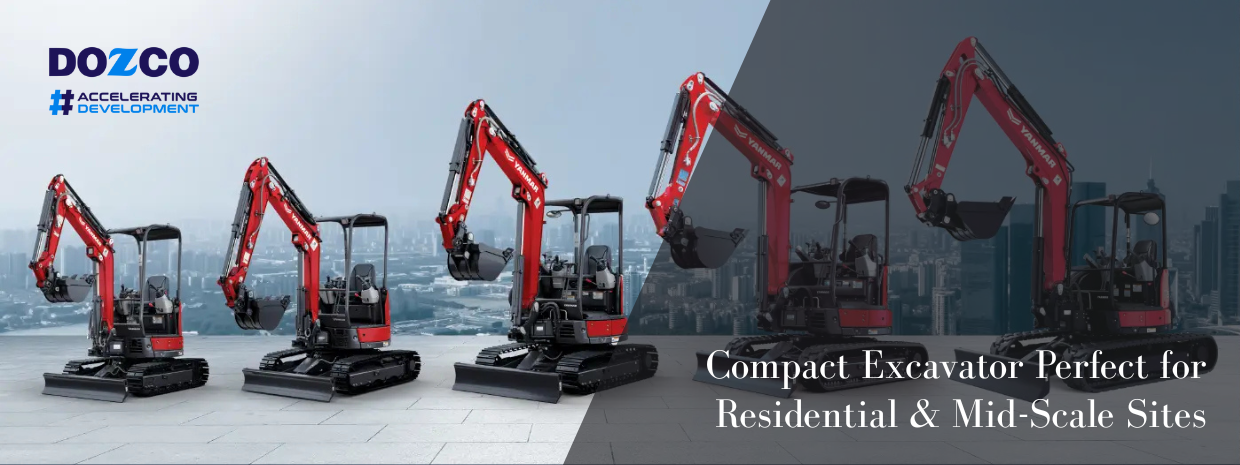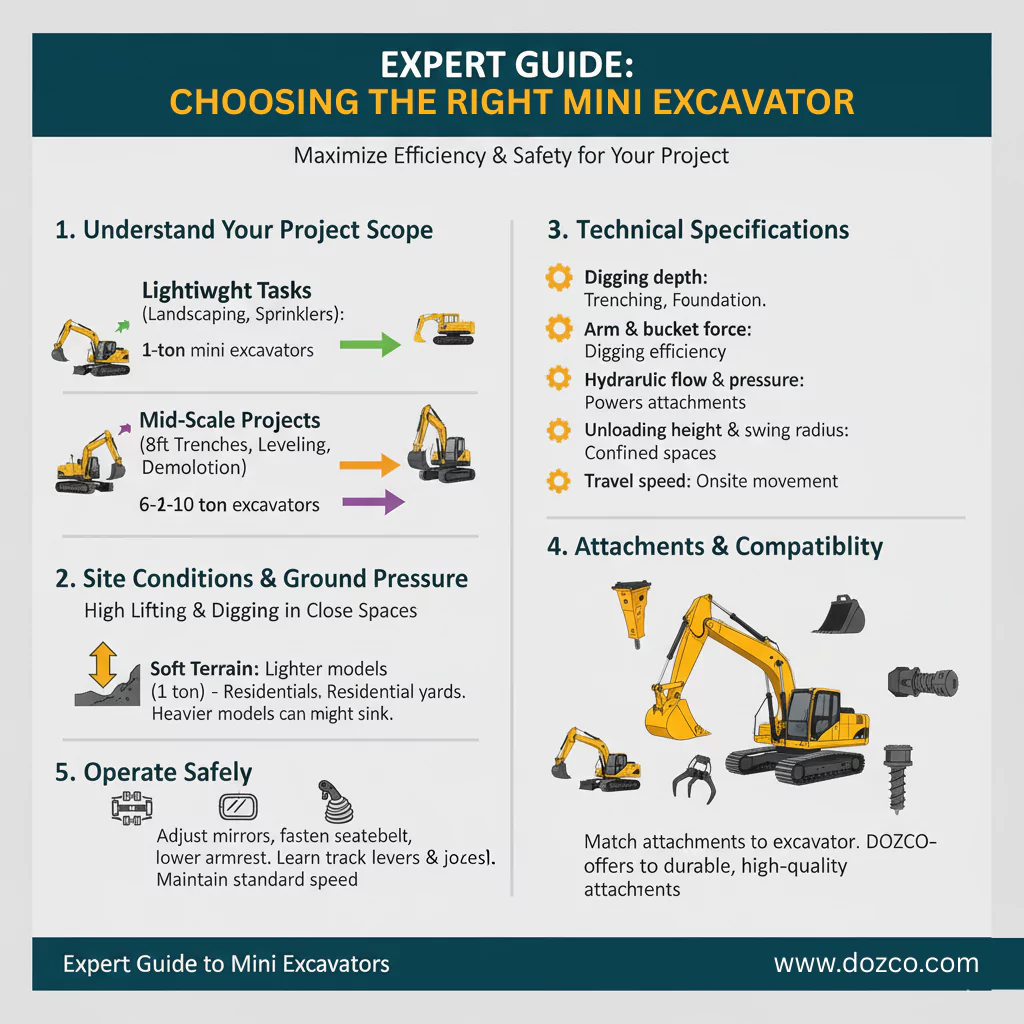For a heavy-duty industry like the construction sector, choosing the right equipment is essential. It helps to avoid costly breakdowns and improve project efficiency. Excavators are one of the most used equipment in the construction industry. It comes in different sizes from large to compact excavators, depending on your project requirements.
For projects wherever space constraints are applicable, mini excavators are preferred. But is it truly the right choice? Won’t a high-powered excavator be more suitable to speed up the process? Let’s find out:
What is a compact excavator?
Mini excavators are purposefully built for trenching and digging for large small-scale construction projects. The special design and compact size make it ideal to work in confined space environments where access is limited. These excavators are lightweight and much easier to transport.
The main components of a compact excavator
i) House
The house or the cab is the central part of the machine. Mounted on the undercarriage via a swing bearing, it holds the operator’s cab, engine, hydraulic pump, and distribution system. It can rotate 360 degrees which offers full slewing capability, making it easier to use in tight spaces.
ii) Undercarriage
Undercarriages are always at the bottom of the excavator. It has rubber tracks wrapped around drive sprockets, rollers, and idlers that propel the machine. Most mini-sized excavators use a retractable H-shaped undercarriage, which reduces the width of the machine, so they can easily go through narrow passages. Moreover, the special design also gives the machine more stability.
Many operators prefer steel track undercarriage, as these can handle abrasive or rocky terrain better than rubber tracks. These undercarriages perform better on slopes, loose gravel, mud, or forestry areas. While rubber tracks are ideal for mini excavators working in narrow or urban environments, Steel tracks are better suited for open rough terrain and abrasive sites.
iii) Workgroup
It is the digging arm that is in front of the excavator. It consists of a boom, an arm or dipper, and an attachment, like a bucket, auger, breaker, etc. The workgroup connects to the house via a swing frame and is powered by a hydraulic which lets it swing left and right.
iv) Backfill Blade
Mini excavators often come with a backfill blade. It is controlled from the operator’s cab and hydraulically activated which helps in grading, leveling, backfilling, and dozing. The backfill blade can also stabilize the machine.
Advantages of Using Mini Excavators for Small & Mid-scale Construction Projects
Compact excavators serve a plethora of advantages for small and mid-scale construction projects, including:
a) Breaking Concrete
Concretes are strong and durable construction materials that can be very difficult to break. You need powerful equipment like an excavator. But for urban areas with buildings close by, a large excavator can’t enter. A mini sized excavator thus is preferred by engineers and builders. It uses hydraulic systems that put enough pressure on the concrete to shatter it.
b) Consumes less fuel
Another advantage of mini-sized excavators is that they consume less fuel. With the price of fossil fuels, like diesel and petrol increasing, using an excavator is an expensive investment.
c) Emits less pollutants
Pollution control is a global concern. The pollution caused by vehicles still leads to a large amount. Compact excavators have a smaller engine, which reduces fuel consumption, resulting in less particulate matter and toxic gas emissions. Moreover, some of these excavators can also run on electricity, which makes them much more environmentally friendly.
d) Low Noise
People get tired of the constant mechanical noise that comes from running an excavator. Especially in a densely populated area, it can affect the quality of life for the resident and impact their physical health. Mini excavators produce much less noise, especially the electrical ones, which has led to an increase in their popularity.
How to choose the right mini excavator for your construction project?
While a mini sized excavator comes with a range of practical applications and benefits, it is essential to know whether it is suitable for your project. The excavator also comes in different sizes. Here’s an expert guide to choosing the right excavator for your project:
1. Understand your project scope
The first step is always to understand your project demands. If you are dealing with lightweight tasks like backyard landscaping or installing a home sprinkler system, 1-ton mini excavators are much easier to operate.
For mid-scale projects, such as digging trenches up to 8 feet or leveling surfaces, residential work, or light demolition, a 1-2-ton machine is preferable. These machines offer the best capacity within that size range.
6–10-ton excavators also fall under mini and mid-sized excavators. These are well-suited for high lifting and digging in close spaces.
2. Consider Ground Bearing Pressure and Site Conditions
Before you decide on an excavator, you need to thoroughly inspect the site. The ground bearing pressure of the excavator also impacts stability, lifting strength, and ground condition. A heavier excavator might sink on soft terrain, while uneven terrain can lead to damage.
On the other hand, if you pick a very lightweight excavator, let’s say a 1ton one. Depending on the project’s needs it may slow down your workplace. We recommend using lighter models in residential yards with soft landscaping. Go for heavier models when working on compact soil or rugged terrain.
3. Look into the Technical Specifications
The weight of an excavator is not the only factor. You also need to evaluate the technical specifications to make the right decision. Consider the following metrics:
- Digging depth: It is needed, if you’re doing trenching or foundation work.
- Arm and bucket force: It helps in determining the digging efficiency and breakout power.
- Hydraulic flow and pressure: The amount of pressure applied can impact how well the machine powers attachments.
- Unloading height and swing radius: It is crucial in confined spaces or near walls.
- Travel speed: It can influence how quickly you can change the position of the machine onsite.
4. Check the Attachments and Their Compatibility
In most cases, construction jobs demand using excavator attachments. However not all attachments are suitable for your excavator. So, make your decision wisely. At DOZCO, we manufacture high quality excavator attachments, including Rock Breakers, Buckets, Vibro Ripper, Drum Cutters, Auger, Grapple, and Pulverizer in different sizes. All the attachments are made of advanced technology which makes them more durable.
5. Know how to operate safely
When operating an excavator, no matter the size, you need to take precautions. The basic gestures can keep you and those around you safe. For instance, adjust mirrors, fasten seat belts, and lower the safety armrest, before operation. You should also familiarize with how to use the track levers, and joysticks for boom and move the bucket smoothly. Maintaining a standard speed allows you to keep in control and avoid accidents.
Wrap Up
Compact excavators are specially designed for small and mid-scale construction projects. These machines produce low noise, are environment-friendly, and can improve your project speed. However, there are many variations available, so do your research before choosing the right one.
FAQs
1. Are compact excavators different from normal excavators?
Yes, mini-sized excavators are made for using narrow spaces. These excavators are also much smaller in size, lightweight, fuel efficient and easier to transport.
2. Are these small excavators used for demolition?
Yes, mini excavators are used for both construction and demolition. You can use the right-sized attachment like a rock breaker for your projects. However, keep in mind that they might not be ideal for heavy concrete structures.
3. Are these easier to operate for beginners?
Yes, these are much easier to control and operate, which makes it ideal if you’re a beginner.


